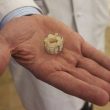Original Title: Transcatheter or Surgical Aortic-Valve Replacement in Intermediate-Risk Patients. PARTNER 2A. Reference: Martin B. Leon et al. NEJM April 2, 2016 Courtesy of Dr. Juan A. Terré Studies have shown mortality rates after transcatheter aortic valve replacement (TAVR) and surgical aortic valve replacement (SAVR) in high risk patients are similar (PARTNER 2 – Cohort B). This is...
SOURCE XT: Results of the latest generation of the Edwards valve
The first generation of the Edwards valve was stainless steel and bovine pericardium with a profile of 22 to 24 Fr for transfemoral access and up to 33 Fr to apical access. From 2010 it became cobalt chromium bovine pericardium with a higher profile, (18-19 Fr for transfemoral and 24-26 Fr for transapical). 2,688 patients...
Transradial Angioplasty: do we need more proof to adopt it for good?
Original title: Influence of Arterial Access Site Selection on Outcomes in Primary Percutaneous Coronary Intervention. Are the Results of Randomized Trials Achievable in Clinical Practice? Reference: Mamas A. Mamas et al. J Am Coll Cardiol Intv 2013. Article in press. Antithrombotic therapy has improved the prognosis of patients with acute ST-segment elevation myocardial infarction by reducing ischemic events....
Use of Transjugular Echocardiography in TAVR
TAVR is a well-established course of treatment, increasingly indicated in lower risk populations. However, one of the challenges associated with self-expanding TAVR, compared against balloon expandable TAVR and SAVR, is the frequent need for definite permanent pacemaker implantation (PPI). High implantation, also known as cusp overlapping (COT), has been shown to reduce the need for...
Contemporary Outcomes of CTO PCI in Europe: The ERCTO Registry
Roughly 20% or coronary angiographies show some form of chronic total occlusion (CTO), and this figure is twice as high for diabetic patients or those with cardiac failure and reduced ejection fraction (EF). CTO percutaneous intervention (PCI) has experienced a significant growth thanks to the development of new techniques and dedicated material. However, a considerable...
Cause of Cardiac Death after TAVR at Present
Cardiac failure (CF) and sudden cardiac death (SCD) stand out as two of the main causes of death in patients with aortic stenosis. Although transcatheter aortic valve intervention has shown higher survival, these two continue to be the main conditions leading to patient death at followup. In its early days, TAVR also showed benefits, but...
MIL Training More MIL: Training Session at ICBA!
The scholarship program MIL Training More MIL continues at specialized centers in Buenos Aires. Yesterday, (Tuesday 26/09), selected female interventionists attended the Cardiovascular Institute of Buenos Aires (ICBA), where an intense session on structural heart disease took place. There were 2 live cases on bicuspid valve and complex access, transfemoral and trans-iliac respectively, both with...
VASC-OBSERVANT II Substudy: Impact of Vascular Complications after TAVR
At present, transcatheter aortic valve replacement (TAVR) has become increasingly common to treat severe symptomatic aortic stenosis, with the transfemoral approach being the most common access strategy, associated to better outcomes vs. other access sites. Even though vascular complication rates (VC) have dropped given increased operation experience and improved devices, such as the use of...
New-Generation ACURATE Neo2
Transcatheter aortic valve replacement (TAVR) is a therapeutical option for patients with symptomatic severe aortic stenosis. Current guidelines recommend TAVR in patients ≥75 years with intermediate risk. One of the most frequent complications of this procedure is moderate or greater aortic regurgitation (AR) after implantation. Consequently, new valves have been developed to try and reduce...
SOLACI/SIAC Latin American Clinical Guidelines on TAVR vs. SAVR Published
The Latin American Society of Interventional Cardiology is proud to announce that the Latin American Clinical Guidelines on TAVR vs. SAVR on patients with severe aortic stenosis have been published. This high-quality scientific work was published in the Heart BMJ Journal and is the result of an arduous joint effort between SOLACI (through its Research...









